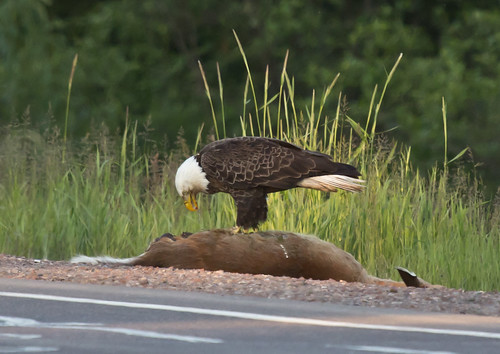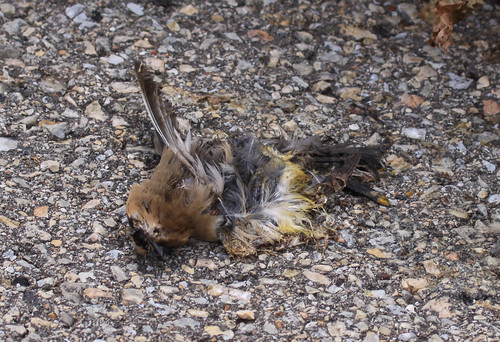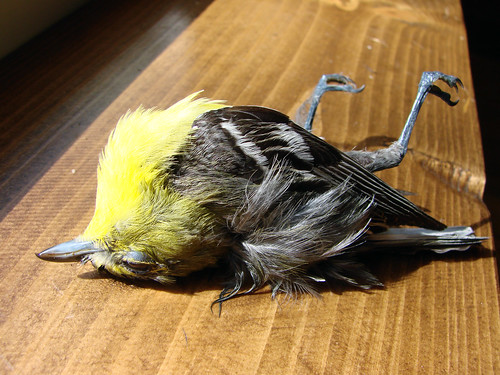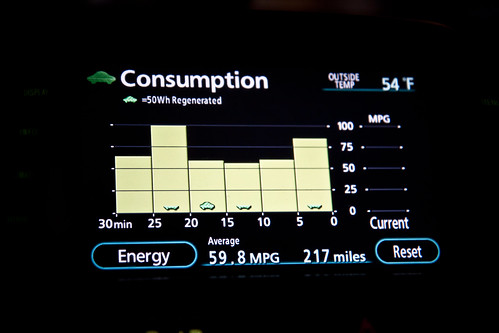 |
| Bald Eagles attracted to any form of roadkill are more vulnerable to being killed by cars, too. |

How many birds are killed on our highways each year? David Sibley, using fairly old figures from the US Fish and Wildlife Service, has an estimate on his webpage that cars may kill 60 million birds per year. He notes, “Of over 8 million lane miles of roads in the US, 6.3 million, or over ¾, are in rural areas where most birds are presumably killed. So this is a significant problem.”

My daughter and her partner Michael got gruesome confirmation of the magnitude of the problem when they bicycled from San Diego to the Florida coast in 2008, photographing all the roadkill they came across. They wrote about it, and the photos are available at http://roadkill.michaelgeraci.com/.
In May 2014, researchers of an important study assessing the death toll published their findings in The Journal of Wildlife Management. They reviewed the literature and used 20 mortality rates they’d extracted from 13 studies to more accurately quantify the mortality. They determined that the estimated bird kill in car collisions is much higher than previously believed, with a lower limit of at least 89 million, and as many as 340 million birds per year.

To me, it’s always been rather a no-brainer why birds get hit. No natural predators achieve the speeds that many autos do, at least not in most areas, and of course naïve birds would have no clue what cars even are. And whether it's the noise or sight of a car, the reactions of other birds, or simple random chance that makes a bird fly off in time to avoid a collision, it isn’t necessarily a learning experience in and of itself that can easily be generalized.
It’s not as if birds are the only wildlife that are killed by cars. Intelligent mammals, including mountain lions and foxes, are also killed by moving vehicles, as indeed are humans—and we’re the ones who from infancy experience and learn to understand cars.
Scientists have been trying to work out the exact reasons why birds so often are killed in collisions with cars and airplanes. In one study for the Royal Society for the Protection of Birds released in December 2014, scientists set up Brown-headed Cowbirds in a virtual reality set-up, with a projected virtual car approaching at various speeds. They found that avoidance behaviors of the cowbirds were based on the birds’ distance from an object rather than its speed, so as the speed increased, the birds didn’t initiate flight soon enough and would have collided had the vehicles been real rather than virtual.

A somewhat similar study published in PLOS ONE in February 2014 used Turkey Vultures lured to roadsides with bait carcasses and real vehicles to establish that the birds flew off fairly easily in response to approaching vehicles going 37 miles per hour or slower, but when vehicles approached at 55 mph, the vultures didn’t take off in time 17 percent of the time.
One thing that does affect how quickly birds react to a vehicle is the speed limit on that stretch of road. A 2013 study conducted in France found that birds do adapt somewhat—the higher the speed limit, the sooner they take flight as a car approaches. Even here, the birds may not be directly responding to a particular car’s speed, but to their distance from the car, or their “Flight Initiation Distance.”
On his webpage, David Sibley writes, “There’s not much we can do about this source of bird mortality short of changing our driving habits, but landscaping the roadside to discourage birds from congregating there is helpful.” But his “short of changing our driving habits” is the operative phrase. One of the simplest yet most effective ways we can help birds is to drive at the slowest speed that is safe, courteous, and convenient. That little change both gives birds and other animals more of a chance to react and gives us more of a chance to adjust our driving to safely accommodate them. Slowing down also significantly improves our fuel efficiency, saving us money, reducing emissions, and conserving natural resources. When everyone slows down, it’s also safer for people, so it’s win-win on every front except for alleviating that infernal need to speed that every element of our modern world fosters.
 |
| My Prius gets its best mileage when I can drive 42 mph on country roads. Unfortunately, that's neither safe nor courteous on stretches where other cars are going faster. |